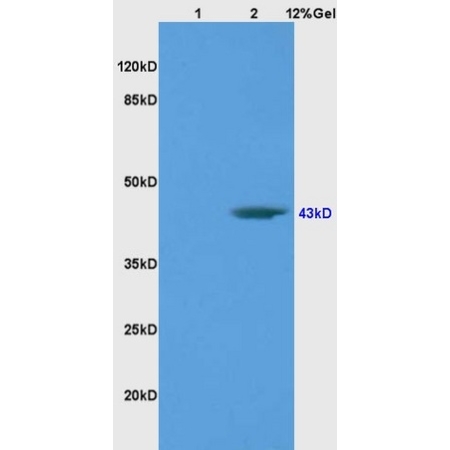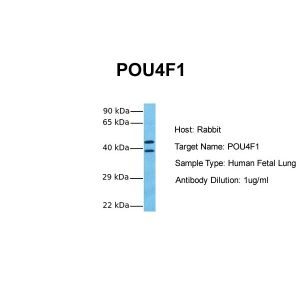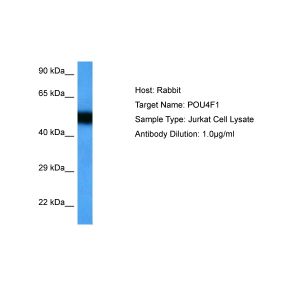POU4F1 Antibody
Référence OABF01290
Conditionnement : 100ul
Marque : Aviva Systems Biology
| Datasheets/Manuals | Printable datasheet for POU4F1 Antibody (OABF01290) |
|---|
| Tested Species Reactivity | Human, Mouse, Rat |
|---|---|
| Predicted Species Reactivity | Bovine|Chicken|Dog|Human|Mouse|Porcine|Rabbit|Rat |
| Product Format | Liquid.Aqueous buffered solution containing 1% BSA, 50% glycerol and 0.09% sodium azide. |
| Clonality | Polyclonal |
| Isotype | IgG |
| Host | Rabbit |
| Conjugation | Unconjugated |
| Application | ELISA, FC, ICC, IF, IHC-Fr, IHC-P, WB |
| Additional Information | Subcellular location: Nucleus |
| Reconstitution and Storage | -20°C |
| Immunogen | KLH conjugated synthetic peptide derived from human BRN3A |
| Purification | Protein A Purified |
| Concentration | 1 ug/ul |
| Application Info | WB: 1:300 - 1,000 IHC-P: 1:200 - 400 IHC-F: 1:50-200 ELISA: 1:500-1000 FC: 1:20-100 Fluorescent (IHC-P): 1:50-200 Fluorescent (IHC-F): 1:50-200 Fluorescent (ICC): 1:50-200 Optimal dilutions should be determined by the end user. |
| Gene Symbol | POU4F1 |
|---|---|
| Gene Full Name | POU class 4 homeobox 1 |
| Alias Symbols | ATITHS;brain-specific homeobox/POU domain protein 3A;brn-3A;BRN3A;homeobox/POU domain protein RDC-1;Oct-T1;POU domain, class 4, transcription factor 1;RDC-1. |
| NCBI Gene Id | 5457 |
| Protein Name | POU domain, class 4, transcription factor 1 |
| Description of Target | Multifunctional transcription factor with different regions mediating its different effects. Acts by binding (via its C-terminal domain) to sequences related to the consensus octamer motif 5'-ATGCAAAT-3' in the regulatory regions of its target genes. Regulates the expression of specific genes involved in differentiation and survival within a subset of neuronal lineages. It has been shown that activation of some of these genes requires its N-terminal domain, maybe through a neuronal-specific cofactor. Ativates BCL2 expression and protects neuronal cells from apoptosis (via the N-terminal domain). Induces neuronal process outgrowth and the coordinate expression of genes encoding synaptic proteins. Exerts its major developmental effects in somatosensory neurons and in brainstem nuclei involved in motor control. Stimulates the binding affinity of the nuclear estrogene receptor ESR1 to DNA estrogen response element (ERE), and hence modulates ESR1-induced transcriptional activity. May positively regulate POU4F2 and POU4F3. Regulates dorsal root ganglion sensory neuron specification and axonal projection into the spinal cord. Plays a role in TNFSF11-mediated terminal osteoclast differentiation. Negatively regulates its own expression interacting directly with a highly conserved autoregulatory domain surrounding the transcription initiation site. |
| Uniprot ID | Q01851 |






